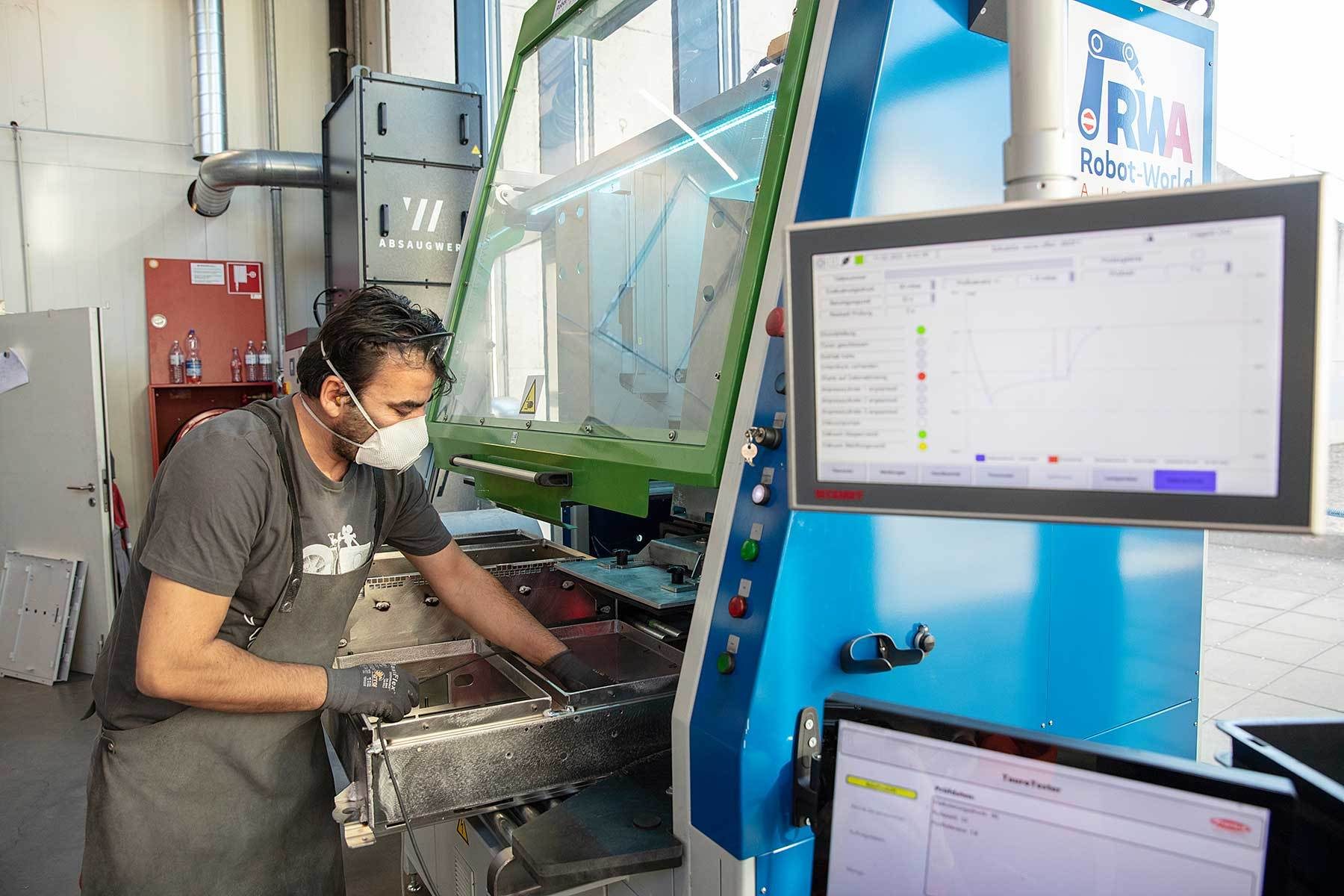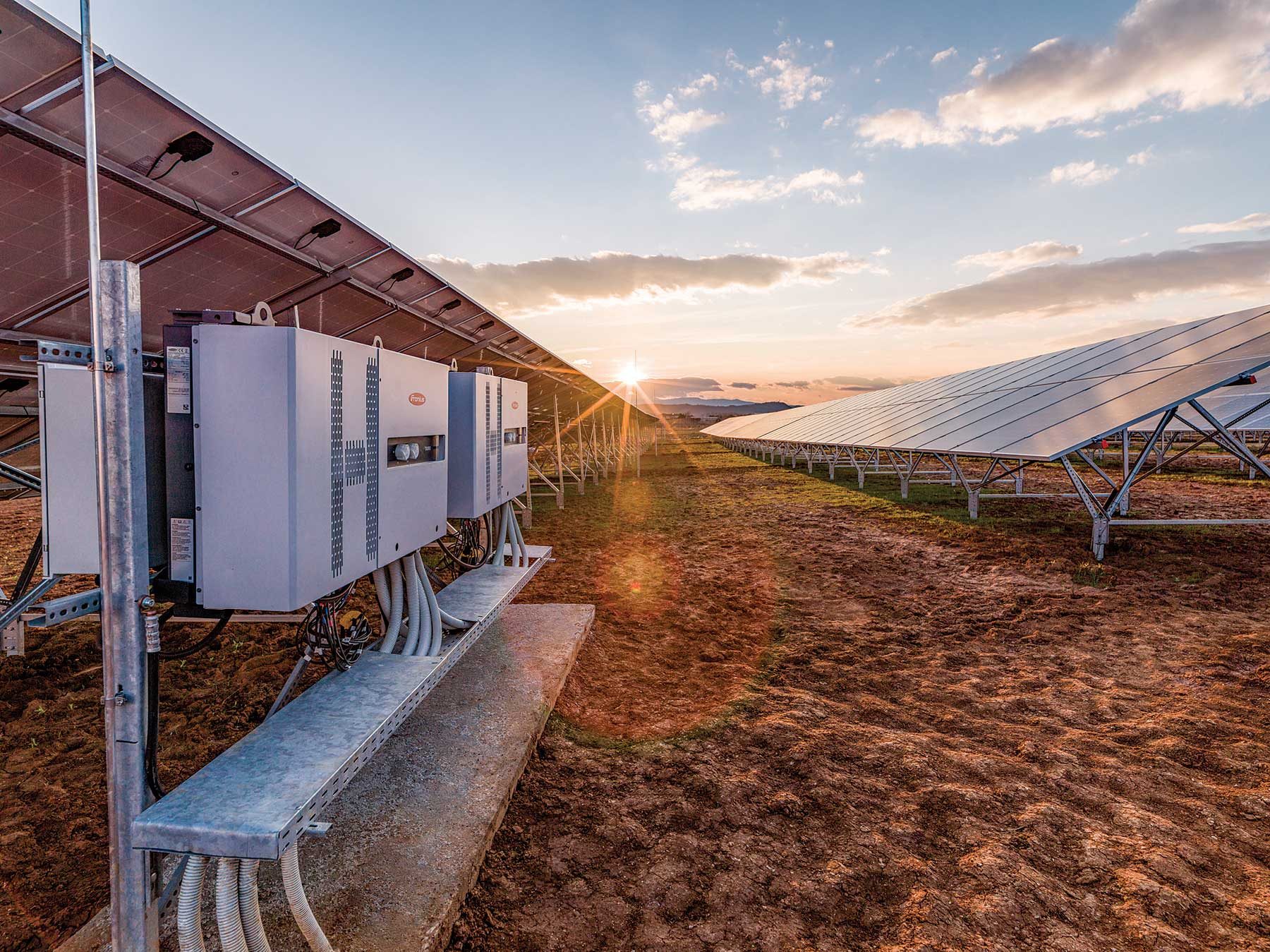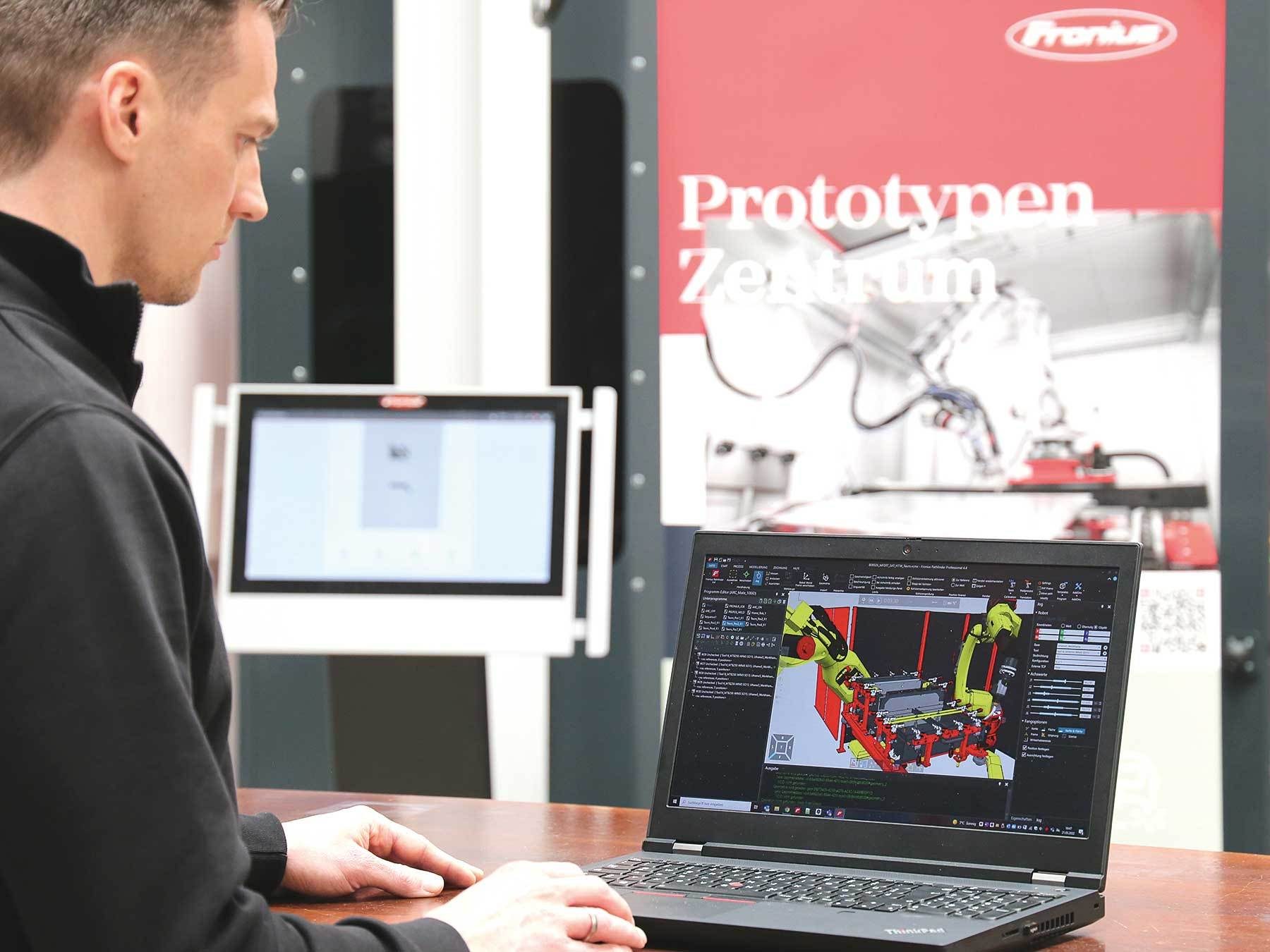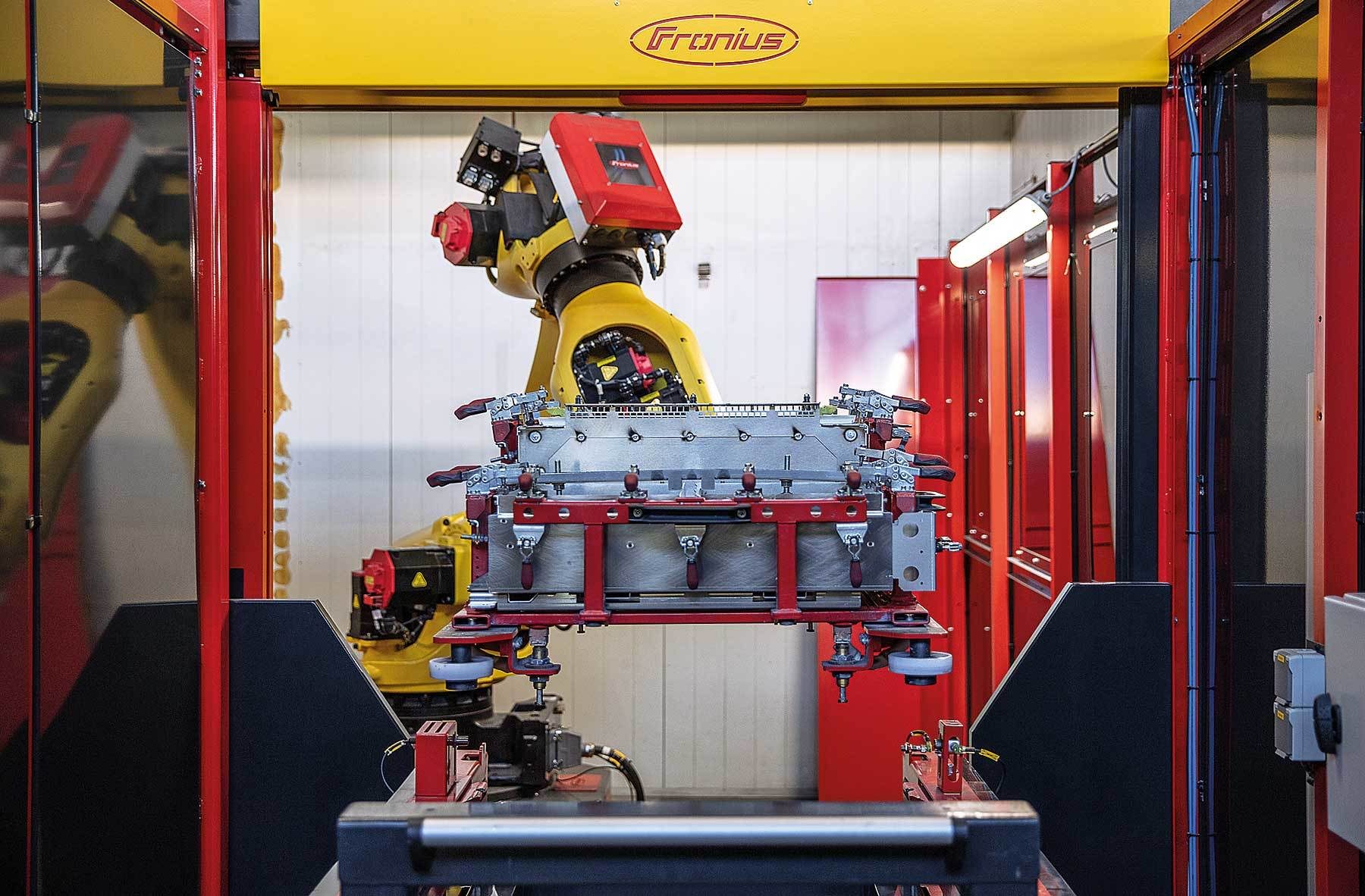MARCH 2023

Robotics
Robots Automate Welding of Aluminum Parts
Automated cell produces leak-proof housings for solar power inverters.
Labor shortages are driving new demand for automation.
Options for Screwfeeding
A FANUC R-2000iD positions an inverter case for welding by a FANUC ARC Mate 100iD. Photo courtesy Fronius Perfect Welding
John Sprovieri // Chief Editor
The heart and brain of every photovoltaic (PV) system is the inverter, which converts direct current generated by solar panels into alternating current that can be used in a home or business. The inverter also optimizes the yield, controls energy flows, and checks the function of the PV system.
One of the leading manufacturers of inverters for PV systems is Fronius Solar Energy based in Wels, Austria. A division of Fronius International GmbH, Fronius Solar Energy introduced its first inverter, the Sunrise, back in 1994, and it has been a market leader ever since.
Its latest inverter, the Tauro, has a double-walled, actively cooled aluminum housing that makes it ideal for use outdoors. To withstand the elements, the inverter is sealed to IP65 ingress protection standard. Meeting that standard depends, in part, on the company’s ability to create high-quality welded seams.
“Due to the different sheet thicknesses, the challenges related to welding the aluminum housing were huge,” explains Jasmin Gross, product marketing manager at Fronius Solar Energy.
Thankfully, Fronius Solar Energy did not have to look far for help. Welding happens to be the specialty of another Fronius International division, Fronius Perfect Welding.
See us at The Assembly Show South, Booth 209

Start With Simulation
The inverter is produced at Fronius Solar Energy’s assembly plant in nearby Sattledt, Austria. The housing and swing doors are welded in a state-of-the-art robotic welding cell that was developed specifically for this job.
“We program and simulate all robot movements and welding sequences offline with Fronius Pathfinder digital twin software,” explains Anton Leithenmair, head of welding automation at Fronius Solar. “This enables us to detect any interference contours in advance. The same applies to axis limits and torch positions. Again, we can intervene early, without having to wait until the first welding samples.
“As soon as the welding sequences have been programmed, Pathfinder transfers the data to the post-processor, where it is translated into the language of the FANUC robot. This allows us to save valuable time and costs. Offline programming shortens the robot teaching process in the welding cell by several hours.”
Before production begins, orders for the Tauro are created in an enterprise resource planning system. This data forms the basis for material resource planning. This is where all production orders for housings and wing doors are generated. Next, a production date is assigned to every order. The detailed planning that follows is carried out by the manufacturing execution system. Every order is planned down to the minute, assigned to a free order corridor, and then listed.

Each inverter housing is subjected to a pressure decay leak test. Photo courtesy Fronius Perfect Welding
Due to the different sheet thicknesses, the welding of the double-walled inverter housing posed a particular challenge from the outset. “Before we join the individual sheet elements in the robotic welding cell in line with standards, they are manually pre-tacked. We use the MAG [metal active gas] welding process for this. Even at this stage, precise work is required,” says Christian Kraus, group leader in sheet metal production at Fronius Solar.
Once tacking is complete, and this has been entered on the system terminal, the central system controls release the next step: robotic welding. The housing is now placed on the setup trolley, clamped and moved into the lock. Once this has been acknowledged, the system starts the next job, and the robot program responsible for positioning and welding is selected on the clamping device by means of an radio frequency identification (RFID) chip.
“Regardless of which component we place in the lock, the RFID chip knows which welding program to use,” adds Kraus. “We can even place an inverter housing in lock one while welding a wing door in lock two via the component feeder. And vice-versa. The use of RFID technology enables us to weld components completely independently of their shape, size and quantity. Whether it’s a batch size of one or series production, our robotic welding cell can do it all.”

The Tauro inverter has a double-walled, actively cooled aluminum housing that makes it ideal for use outdoors. Photo courtesy Fronius Perfect Welding
Robotic Welding

Engineers at Fronius Solar program and simulate all robot movements and welding sequences offline with Fronius Pathfinder digital twin software. Photo courtesy Fronius Perfect Welding
“Pulse multi control (PMC) ripple drive is the preferred welding process,” explains Leithenmair. “PMC ripple drive permits precise adjustment of the heat input and is perfect for joining sheets of different thicknesses.”
Ripple drive is a special characteristic of the PMC process. One of its main features is a cyclical process switch between PMC and a reversing wire movement via a so-called push-pull drive unit. Designed for automated welding, the PMC method is much faster than TIG welding. This process delivers rippled, virtually spatter-free welds.
A 1.2-millimeter-thick aluminum-silicon wire is used as the filler material, which is welded with argon shielding gas. The welding processes, wire and gas are all included in the system information for the welding order.
Once the 17.5-minute welding cycle has ended, the handling robot places the component in the lock, and the welding cell sends a completion signal to the MES system. While the one lock is being emptied, the other can start the next job.

A setup trolley heads to the robotic welding cell. Photo courtesy Fronius Perfect Welding
As soon as the welding process has been started, a FANUC R-2000iD/210FH handling robot takes the component and guides it into the welding cell. It requires virtually no effort to lift the inverter housing. With a range of 2.6 meters, the robot has a load capacity of 210 kilograms, whereas the aluminum housing, including the clamping device, weighs no more than 140 kilograms. Once the Tauro housing is inside the welding cell, a Data Matrix code is printed onto the base of the housing using ink-jet printing technology. The code contains the serial numbers of the individual Tauro housings. It is linked to the welding data recorded by the WeldCube data management software during the welding process. This means that every individual weld is 100 percent traceable.
Once the code has been applied, the actual welding process begins. While a FANUC ARC Mate 100iD welding robot is doing its work, joining 5.5 meters of aluminum sheet with a total of 96 welds, the handling robot moves the housing into exactly the right position. Some welds require perfect simultaneous movements of both robots.
“To join forces with a prestigious brand such as Alfa Romeo is an incredible opportunity to develop cutting-edge technologies, and we are proud to see the tangible results of Comau’s field-proven expertise,” says Pietro Gorlier, Comau CEO. “Our commitment to unwavering quality is seen within the processes and products used to make the Tonale, enabling us to ensure maximum value for the customer.”
“In supporting the Alfa Romeo brand in their product expansion, Comau has fully leveraged its long-standing experience in automation and smart manufacturing to deliver an unprecedented level of flexibility,” adds Andrew Lloyd, Comau’s chief of engineering. “This innovative approach to implementing brand-new technologies and retooling existing lines and equipment is a direct result of our commitment to offer increasingly scalable and sustainable solutions, helping our customers better meet their objectives today as well as tomorrow.”

An RFID chip tells the welding cell what piece is being welded. Photo courtesy Fronius Perfect Welding
Robotic Welding
The MES manages a wide variety of data. In addition to order management, it also records machine statuses, cycle times, faults and the values from the vacuum test that is performed once all welding work is complete. Maintenance intervals can also be defined using the MES. If, for example, a certain fault is found to occur every 100 operating hours on average, a specific maintenance interval of 99 hours can be set. Maintenance work that is systematically planned in advance extends the service life of welding systems and prevents unnecessary downtimes.
The few housing details that cannot be completed by the robot are welded manually. A specially designed TIG process is used for the aluminum welding in this case. Once all welding work is complete, any welding reinforcements are sanded down, the welds are coated with dye penetrant test fluid and checked for welding faults. Here the test fluid penetrates any imperfections in the material.
Once the weld testing is complete, every approved housing enters the leak testing system specially developed by Fronius for the Tauro. This creates a vacuum of 60 millibars inside the inverter housing, which must be maintained for a precisely defined period of time. If the pressure drops by less than 1.8 millibars during this time, the housing is 100 percent leak-tight and satisfies degree of protection IP65.
After the leak test has been passed, the result is saved in WeldCube with the serial number and full traceability is guaranteed. The inverter housing is now ready for powder coating.
For more information on welding technology, click www.fronius.com/en/welding-technology.
For more information on welding and handling robots, click www.fanucamerica.com.

ASSEMBLY ONLINE
For more information on robotic assembly, visit www.assemblymag.com to read these articles:


